To Be The Best: The top 100 boxers in the history of The Ring Rankings (60-51)

If you’re new to this on-going series, please read:
***
One of the most accomplished and long-reigning heavyweight champions of all time is joined in this group by two of the most popular and celebrated heavyweight champs ever. (It makes you wonder how amazingly accomplished the fighters who made the first half of this list must be.)
The heavyweights are good company. This group includes two of Sugar Ray Robinson’s toughest middleweight rivals, two dominant lightweight kings (whose title reigns are separated by 60 years), an all-time great from Puerto Rico, one of Britain’s most talented champions, and a forgotten Olympic gold medalist who faced the best featherweights, lightweights and welterweights of the late 1920s/early 1930s.
***
#60 – Wladimir Klitschko
Career Record: 64-5 (53 KOs, 4 KOBY)
First Ring Ranking: #6 Heavyweight (March 2001)
Last Ring Ranking: #3 Heavyweight (November 2017)
Record vs. Ring-rated Opponents: 15-4 (9 KOs, 3 KOBY)
Overall Score Rank: 80
Peak Score Rank: 78
Win Total Rank: 73
Ring Magazine Championships: Heavyweight (2009-15)

Wladimir won several major heavyweight belts during his extended title reign, including the Ring championship.
Ukraine’s “Dr. Steelhammer” won super heavyweight gold at the 1996 Olympics and overcame some rough setbacks to dominate heavyweight for nearly a decade. Klitschko rose to number one from the April 2002-June 2003 issues before losing the WBO belt in an upset to Corrie Sanders. Klitschko fell out of the rankings altogether for more than a year after a loss to Lamon Brewster before working his way back to number one in the August 2006 issue. Klitschko unified the IBF, WBO, and WBA belts and earned recognition as world champion in The Ring as champion for over six years before losing again to Tyson Fury. Klitschko wouldn’t fall below number one contender again until his loss to Joshua in the final fight of Klitschko’s career.
Missing Quality: Klitschko’s first loss to Ross Purrity came before Klitschko entered the rankings for the first time. While well past Ray Mercer’s years in the rankings, Klitschko did hand the perennial 90s contender his first stoppage loss. Klitschko also had solid wins over unranked Axel Schulz and Monte Barrett early in his career. Barrett would enter the rankings years later and Schulz was unlucky on the cards in a controversial fight with heavyweight leader George Foreman a few years before Schulz faced Klitschko. Wins over former champion Hasim Rahman and a second win over Samuel Peter came when both were unranked.
Scoring Results:
Chris Byrd UD 12 – (8) – Hvy – 02/01
Jameel McCline RTD 10 – (6) – Hvy – 04/03
Corrie Sanders TKO by 2 – (UR) – Hvy – 06/03
Lamon Brewster TKO by 5 – (UR) – Hvy – Summer/04
Samuel Peter UD 12 – (8) – Hvy – V6/05
Chris Byrd TKO 7 – (1) – Hvy – 07/06
Calvin Brock TKO 7 – (9) – Hvy – 02/07
Lamon Brewster RTD 6 – (8) – Hvy – 10/07
Sultan Ibragimov UD 12 – (6) – Hvy – 06/08
Tony Thompson KO 11 – (9) – Hvy – Fall/08
Ruslan Chagaev RTD 9* – (3) – Hvy – 08/09
Eddie Chambers KO 12 – (3) – Hvy – 05/10
David Haye UD 12 – (2) – Hvy – 09/11
Tony Thompson TKO 6 – (10) – Hvy – 09/12
Alexander Povetkin UD 12 – (1) – Hvy – 12/13
Kubrat Pulev KO 5 – (1) – Hvy – 01/15
Bryant Jennings UD 12 – (5) – Hvy – 07/15
Tyson Fury L12* – (3) – Hvy – 03/16
Anthony Joshua TKO by 11 – (5) – Hvy – 07/17
#59 – Carl “Bobo” Olson
Career Record: 97-16-2 (46 KOs, 7 KOBY)
First Ring Ranking: #7 Middleweight (August 1949)
Last Ring Ranking: #9 Light Heavyweight (May 1967)
Record vs. Ring-rated Opponents: 18-14-2 (4 KOs, 7 KOBY)
Overall Score Rank: 125
Peak Score Rank: 61
Win Total Rank: 45
Ring Magazine Championships: Middleweight (1953-55)

Carl Olson was The Ring’s 1953 Fighter of the Year.
Hawaii’s Olson could be found in the rankings of The Ring at middleweight or light heavyweight more often than not for the better part of twenty years, facing a who’s who of the 1950s and 60s. Olson rose to number two contender at middleweight prior to defeating former champion Randy Turpin for the crown left vacant by the retirement of Sugar Ray Robinson. Robinson returned to wrest the title from Olson and then defeated Olson again to defend the title, ultimately winning their career series 4-0. Olson would climb as high as third at light heavyweight after his win over Wayne Thornton but never challenged for the light heavyweight title again after the loss to Archie Moore in 1955.
Missing Quality: Olson defeated several fighters who had or would be ranked but didn’t happen to be ranked in the issue prior to particular fights with Olson. Among them were Joey Giambra, Ralph “Tiger” Jones, and Lloyd Marshall. Olson also defeated a young Andy Kendall. Kendall who would go on to challenge Bob Foster for the light heavyweight title.
Scoring Results:
Tommy Yarosz UD 10 – (3+) – 175 – 07/49
Dave Sands L 12 – (2) – 160 – 05/50
Sugar Ray Robinson KO by 12 – (1) – 160 – 12/50
Dave Sands L 10 – (2) – 160 – 11/51
Sugar Ray Robinson L 15 – (C) – 160 – 04/52
Robert Villemain SD 10 – (10+) – 175 – 08/52
Gene Hairston TKO 6 – (2) – 160 – 10/52
[Lee Sala KO 2 – (6) – 160
Norman Hayes UD 10 – (7) – 160 – 01/53]
Norman Hayes UD 10 – (7) – 160 – 03/53
Paddy Young UD 15 – (3) – 160 – 08/53
Randy Turpin UD 15* – (1) – 160 – 12/53
Kid Gavilan MD 15 – (C-) – 147 – 05/54
Rocky Castellani UD 15 – (1) – 160 – 10/54
Pierre Langlois TKO 11 – (5) – 160 – 01/55
Joey Maxim UD 10 – (1+) – 175 – 05/55
Archie Moore KO by 3 – (C+) – 175 – 07/55
Ray Robinson KO by 2* – (1) – 160 – 01/56
Ray Robinson KO by 4 – (1) – 160 – 06/56
Pat McMurtry KO by 2 – (10) – Hvy – 09/57
Rory Calhoun UD 10 – (9-) – 160 – 05/59
Mike Holt W 10 – (3) – 175 – 07/60
Doug Jones KO by 6 – (8) – 175 – 10/60
Sixto Rodriguez L 10 – (UR) – 175 – 10/61
Pete Rademacher L 10 – (UR+) – Hvy – 05/62
Lennart Risberg KO 6 – (9) – 175 – 07/62
Giulio Rinaldi D 10 – (1) – 175 – 01/63
Hank Casey D 10 – (UR) – 175 – 01/64
Wayne Thornton MD 10 – (7) – 175 – 05/64
Johnny Persol L 10 – (UR) – 175 – 08/64
Wayne Thornton UD 10 – (5) – 175 – 10/64
Jose Torres KO by 1 – (6-) – 160 – 01/65
Piero Del Papa SD 10 – (3) – 175 – 08/66
Don Fullmer L 10 – (4-) – 160 – 01/67
#58 – Lou Ambers
Career Record: 89-8-7 (28 KOs, 2 KOBY)
First Ring Ranking: #10 Lightweight (January 1934)
Last Ring Ranking: Lightweight Champion (June 1940)
Record vs. Ring-rated Opponents: 16-7-4 (2 KOs, 1 KOBY)
Overall Score Rank: 85
Peak Score Rank: 83
Win Total Rank: 61
Ring Magazine Championships: Lightweight (1936-38, 39-40)
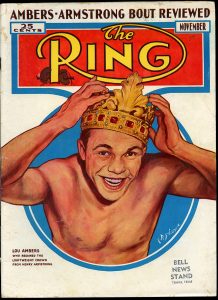
Lou Ambers lost and regained the lightweight crown from the great Henry Armstrong.
New York’s “Herkimer Hurricane” rose to number one at lightweight in 1935 and would be ranked no lower through the remainder of his time in the rankings until Lew Jenkins unseated him to end Ambers’ second title reign in 1940. Ambers got the better of three-fight rivalries with Tony Canzoneri and Baby Arizmendi along with a split of two memorable title clashes with Henry Armstrong. Ambers never returned to the rankings after the first loss to Jenkins. Jenkins was the only man to stop Ambers, repeating the feat in their 1941 rematch.
Missing Quality: Ambers defeated an unranked Cocoa Kid in 1933 between the great Cuban’s first (and only) ranking at lightweight in the October 1933 issue and Kid’s debut in the welterweight top ten in the summer of 1934. Ambers handed Johnny Jadick a 1934 loss just months after Jadick’s final exit from the rankings. A 1935 win over future welterweight champion Fritzie Zivic came roughly a year before Zivic entered the rankings for the first time.
Scoring Results:
[Steve Halaiko L 6 – (8+) – 147
Jackie Davis KO 4 – (9+) – 147 – 06/34]
[Steve Halaiko D 10 – (8+) – 147
Jimmy Leto D 10 – (UR) – 135 – 07/34]
Tony Herrera W 10 – (8+) – 147 – 10/34
Billy Hogan W 10 – (10+) – 147 – 11/34
Harry Dublinsky UD 10 – (3+) – 147 – 02/35
Sammy Fuller UD 15 – (5) – 135 – 04/35
Tony Canzoneri L 15* – (2) – 135 – 07/35
Frankie Klick W 10 – (3) – 135 – 02/36
Baby Arizmendi UD 10 – (3-) – 126 – 03/36
Tony Canzoneri UD 15* – (C) – 135 – 10/36
Eddie Cool L 10 – (UR) – 135 – 12/36
Jimmy McLarnin L 10 – (2) – 147 – 01/37
Enrico Venturi D 10 – (4) – 135 – 02/37
Davey Day SD 10 – (9) – 135 – 03/37
Pedro Montanez L 10 – (1) – 135 – 05/37
Tony Canzoneri UD 15 – (2) – 135 – 06/37
Pedro Montanez MD 15 – (1) – 135 – 11/37
Frankie Wallace UD 10 – (9) – 135 – 01/38
Baby Arizmendi D 10 – (UR) – 135 – 07/38
Henry Armstrong L 15* – (C-/C+) – 126/147 – 09/38
Tommy Cross UD 10 – (7) – 135 – 01/39
Baby Arizmendi TKO 11 – (7) – 135 – 04/39
Henry Armstrong UD 15* – (C/C+) – 135/147 – 10/39
Al “Bummy” Davis UD 10 – (10+) – 147 – 04/40
Lew Jenkins TKO by 3* – (UR) – 135 – 06/40
#57 – Sugar Shane Mosley
Career Record: 49-10-1 (41 KOs, 1 KOBY)
First Ring Ranking: #9 Lightweight (August 1994)
Last Ring Ranking: #10 Welterweight (May 2012)
Record vs. Ring-rated Opponents: 14-7-1 (9 KOs)
Overall Score Rank: 53
Peak Score Rank: 65
Win Total Rank: 88
Ring Magazine Championships: Jr. Middleweight (2003-04)
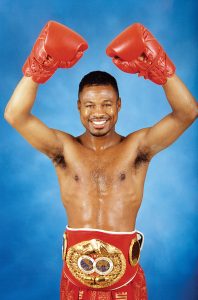
Shane Mosley during his reign as IBF lightweight titleholder in 1998. Photo from The Ring archives
“Sugar” Shane followed an impressive, eight-defense IBF title reign at lightweight with title runs at welterweight and jr. middleweight. Mosley moved to number one at lightweight in the September 1998 issue after WBA titlist Orzubek Nazarov’s upset loss to Jean Baptiste Mendy. Mosley would be ranked number one at welterweight from the November 2000 issue until his first loss to Vernon Forrest and then as number one contender to the welterweight crown until a move to jr. middleweight. Mosley would return to number one at welterweight for most of 2009 after a masterful battering of Antonio Margarito.
Missing Quality: A welterweight win over unranked Willy Wise came one fight after Wise’s upset of Julio Cesar Chavez. Former welterweight champion Ricardo Mayorga gave Mosley a good fight in 2008 but was years removed from the rankings. Mosley’s final exit from the rankings came just a few months before a loss to Saul Alvarez.
Scoring Results:
Phillip Holiday UD 12 – (1) – 135 – 12/97
John John Molina TKO 8 – (8+) – 140 – 08/98
Jesse James Leija RTD 9 – (10) – 135 – 02/99
John Brown TKO 8 – (9-) – 130 – 07/99
Wilfredo Rivera KO 10 – (10++) – 147 – Holiday/99
Oscar De la Hoya SD 12 – (1) – 147 – 10/00
Antonio Diaz TKO 6 – (4-) – 140 – 02/01
Shannan Taylor RTD 5 – (7) – 147 – 06/01
Vernon Forrest L 12* – (3) – 147 – 05/02
Vernon Forrest L 12 – (C) – 147 – 11/02
Oscar De La Hoya UD 12* – (C) – 154 – 12/03
Winky Wright L 12* – (2) – 154 – 07/04
Winky Wright L 12 – (C) – 154 – Winter/05
David Estrada UD 10 – (9-) – 147 – Summer/05
Fernando Vargas TKO 10 – (4+) – 154 – 06/06
Fernando Vargas TKO 6 – (6) – 154 – 10/06
Luis Collazo UD 12 – (5-) – 147 – 05/07
Miguel Cotto L 12 – (1) – 147 – 02/08
Antonio Margarito TKO 9 – (1) – 147 – 04/09
Floyd Mayweather L 12 – (3) – 147 – 07/10
Sergio Mora D12 – (UR+) – 154 – 11/10
Manny Pacquiao L 12 – (1) – 147 – 07/11
#56 – Jack “Kid” Berg
Career Record: 157-26-9 (61 KOs, 9 KOBY)
First Ring Ranking: #8 Lightweight (August 1928)
Last Ring Ranking: #7 Lightweight (October 1935)
Record vs. Ring-rated Opponents: 14-10-3 (2 KOs, 3 KOBY)
Overall Score Rank: 87
Peak Score Rank: 32
Win Total Rank: 82
Ring Magazine Championships: Jr. Welterweight (1930-32)
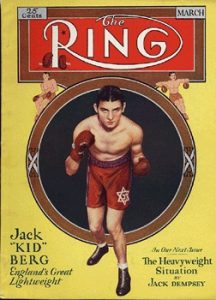
Jackie “Kid” Berg graces the cover of the March 1930 issue of The Ring.
England’s “Whitechapel Windmill” was the rare fighter in the early years of The Ring to be ranked in multiple divisions for an extended period of time. Berg had risen to number-one contender at lightweight in the March 1930 issue just prior to winning the jr. welterweight crown. While reigning in the higher class, Berg resumed as number-one lightweight contender in the August 1930 issue. Rankings columnist Eddie Borden declared it “the first time I’ve ever listed a fellow in more than one class.” Berg would be ranked number one at lightweight for ten of the next eleven issues and then return to the lightweight ranks in 1933.
Missing Quality: Berg fought on for years after exiting the Ring rankings for the last time in 1935, including a 3-0 run in 1945 following service in World War II. The best showing in his post-rankings years was a defeat of ranked lightweight Tippy Larkin. Larkin was ranked fourth in the July 1939 issue just prior to the fight.
Scoring Results:
Freddie Mueller W 10 – (4+) – 140 – 07/28
Billy Petrolle D 10 – (3) – 135 – 08/28
Billy Petrolle TKO by 5 – (4) – 135 – 09/28
[Bruce Flowers W 10 – (3+) – 140
Bruce Flowers W 10 – (3+) – 140 – 06/29]
Stanislaus Loayza D 10 – (4+) – 140 – 07/29
Mushy Callahan UD 10 – (C+) – 140 – 08/29
Bruce Flowers W 10 – (8) – 135 – 11/29
Tony Canzoneri SD 10 – (1) – 135 – 02/30
Mushy Callahan TKO 10* – (C) – 140 – 03/30
Joe Glick UD 10 – (4) – 140 – 05/30
Kid Chocolate SD 10 – (1—) – 126 – 09/30
Joe Glick W 10 – (9) – 140 – 10/30
Billy Petrolle UD 10 – (2) – 135 – 11/30
[Tony Canzoneri KO by 3 – (C) – 135
Tony Herrera W 10 – (1) – 140 – 06/31]
Tony Canzoneri L 15 – (C-) – 135 – 10/31
Sammy Fuller D 10 – (3) – 140 – 05/32
Sammy Fuller L 12* – (2) – 140 – 06/32
Kid Chocolate MD 15 – (C–) – 130 – 08/32
Cleo Locatelli L 10 – (UR) – 135 – 06/33
Tony Falco L 10 – (UR) – 135 – 11/33
Cleto Locatelli L 10 – (UR) – 135 – 02/34
Jimmy Stewart TKO by 3 – (UR) – 135 – 07/34
Gustave “Tiger” Humery TKO 8 – (6) – 135 – 03/35
Gustave “Tiger” Humery L 10 – (UR) – 135 – 04/35
Gustave “Tiger” Humery L 10 – (4) – 135 – 05/35
#55 – Mike Tyson
Career Record: 50-6 (44 KOs, 5 KOBY)
First Ring Ranking: #7 Heavyweight (October 1986)
Last Ring Ranking: #10 Heavyweight (June 2004)
Record vs. Ring-rated Opponents: 13-4, 1 No Contest (10 KOs, 3 KOBY)
Overall Score Rank: 46
Peak Score Rank: 57
Win Total Rank: 95
Ring Magazine Championships: Heavyweight (1988-89)

Mike Tyson’s first Ring Magazine cover – the February 1986 issue.
The face of boxing for a generation of fans, “Iron” Mike cut through the heavyweight top ten like no one since Joe Louis before suffering one of the most memorable upsets in sports history at the hands of Buster Douglas. Tyson was the youngest man ever to win a version of the heavyweight crown at 20 years old, rising to number one contender with that WBC title win over Trevor Berbick. Tyson unified all three major titles by age 21, and stopped Michael Spinks for The Ring and lineal crowns just days shy of his 22nd birthday. Tyson lost roughly four years of his career related to a rape conviction. Tyson won more than he lost after returning to the ring in 1995, recapturing two belts and returning to Ring’s number one spot at heavyweight before a loss to Evander Holyfield. Tyson would never hold a title again.
Missing Quality: Tyson just missed a few more ranked wins. Jose Ribalta entered the top ten in 1987 after giving Tyson some rounds the previous year. Larry Holmes was unranked coming off a lengthy layoff but would return to the top ten off and on for several years in the 1990s. Former titlist Tony Tubbs was unranked prior to his 1988 loss to Tyson but would return to the top ten years later. Frank Bruno was not ranked by Ring prior to the first loss to Tyson but would give Tyson his chance to regain the WBC belt in 1996. Notably, Bruno was ranked in the top ten by KO Magazine prior to the first Tyson fight but it was not used as a supplemental ranking because everyone in Ring’s top ten at the time was an active heavyweight. Tyson defeated the ranked Andrew Golota in their bout but the result was overturned when Tyson tested positive for marijuana.
Scoring Results:
Alonzo Ratliff TKO 2 – (5-) – Cruiser – 10/86
Trevor Berbick TKO 2 – (1) – Hvy – 02/87
James Smith UD 12 – (2) – Hvy – 05/87
Pinklon Thomas TKO 6 – (3) – Hvy – 08/87
Tony Tucker UD 12 – (7) – Hvy – 10/87
Tyrell Biggs TKO 7 – (6) – Hvy – 01/88
Michael Spinks KO 1* – (C) – Hvy – 09/88
Carl Williams TKO 1 – (2) – Hvy – 05/89
Buster Douglas KO by 10 – (7) – Hvy – 05/90
Alex Stewart TKO 1 – (10) – Hvy – 03/91
Donovan Ruddock TKO 7 – (3) – Hvy – 06/91
Donovan Ruddock UD 12 – (3) – Hvy – 10/91
Frank Bruno TKO 3 – (7) – Hvy – 06/96
Bruce Seldon TKO 1 – (8) – Hvy – 12/96
Evander Holyfield TKO by 11 – (5) – Hvy – 01/97
Evander Holyfield DQ by 3 – (1) – Hvy – 10/97
Andrew Golota NC 2 – (9) – Hvy – 02/01
Lennox Lewis KO by 8 – (C) – Hvy – 10/02
#54 – Gene Fullmer
Career Record: 55-6-3 (24 KOs, 2 KOBY)
First Ring Ranking: #8 Middleweight (August 1955)
Last Ring Ranking: #10 Middleweight (July 1964)
Record vs. Ring-rated Opponents: 13-5-3
Overall Score Rank: 39
Peak Score Rank: 49
Win Total Rank: 94
Ring Magazine Championships: Middleweight (1957)
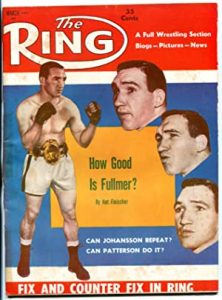
Gene Fullmer won The Ring’s 1959 Fight of the Year vs. Carmen Basilio.
One of the few fighters to get the better of a rivalry with Sugar Ray Robinson, Fullmer was a regular fixture of the Ring rankings for almost a decade at middleweight. Fullmer was 37-3 and held the number one contender spot for seven straight issues before defeating Robinson for the crown. Fullmer suffered one of only two career stoppage losses in the rematch and wouldn’t see Robinson again for several years. Fullmer would never regain The Ring’s championship but won the vacant NBA crown against Carmen Basilio in 1959. Fullmer defended seven times before a three-fight series with Dick Tiger. Fullmer was ranked no lower than third from the July 1957 to December 1963 editions and spent most of the three years from the August 1960-September 1963 issues as number one contender to Ring’s champion.
Missing Quality: Fullmer took a loss to Gil Turner before defeating Turner to propel into the rankings for the first time. Fullmer later defeated Turner to win their series 2-1 after Turner had fallen out of the top ten. Al Andrews had been in the rankings in 1954 at welterweight and middleweight but not the following year when Fullmer bested him. Fullmer’s second win over Carmen Basilio came shortly after Basilio exited the rankings for the final time for inactivity. It should still be regarded as a quality victory.
Scoring Results:
Gil Turner W 10 – (8) – 160 – 07/55
Del Flanagan UD 10 – (6-) – 147 – 09/55
Bobby Boyd L10 – (UR) – 160 – 12/55
Eduardo Lausse L 10 – (4) – 160 – 01/56
Rocky Castellani SD 10 – (4) – 160 – 02/56
Ralph Jones UD 10 – (5) – 160 – 06/56
Charley Humez UD 10 – (1) – 160 – 07/56
Sugar Ray Robinson UD 15* – (C) – 160 – 02/57
Sugar Ray Robinson KO by 5* – (1) – 160 – 06/57
Ralph Jones UD 10 – (7) – 160 – 07/57
Spider Webb UD 10 – (4) – 160 – 10/58
Carmen Basilio TKO 14 – (1) – 160 – 10/59
Spider Webb UD 15 – (2) – 160 – 01/60
Joey Giardello D 15 – (5) – 160 – 05/60
Sugar Ray Robinson D 15 – (5) – 160 – 01/61
Sugar Ray Robinson UD 15 (2) – 160 – 04/61
Florentino Fernández SD 15 – (4) – 160 – 09/61
Benny Paret KO 10 – (C-) – 147 – 01/62
Dick Tiger L 15 – (2) – 160 – 12/62
Dick Tiger D 15 – (C) – 160 – 04/63
Dick Tiger RTD by 7 – (C) – 160 – 09/63
#53 – Rocky Marciano
Career Record: 49-0 (43 KOs)
First Ring Ranking: #9 Heavyweight (June 1950)
Last Ring Ranking: Heavyweight Champion (June 1956)
Record vs. Ring-rated Opponents: 11-0 (9 KOs)
Overall Score Rank: 30
Peak Score Rank: 41
Win Total Rank: 111
Ring Magazine Championships: Heavyweight (1952-56)
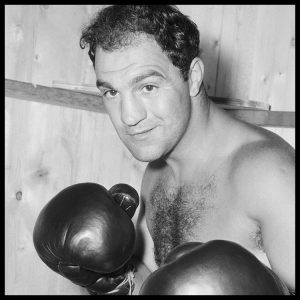
Rocky Marciano was The Ring’s 1952, 1954 and 1955 Fighter of the Year.
The “Brockton Blockbuster” was the only heavyweight champion to retire undefeated and resist the urge to return. Marciano rose to number one contender in the August 1952 issue and held the spot until knocking out Jersey Joe Walcott for the crown. Marciano’s reign as champion was compact but he faced the best of his time with five of six challengers ranked number one going into the fight. Marciano was taken the distance in only one of his seven championship contests and immediately added Ezzard Charles to his list of knockout victims in their rematch.
Missing Quality: Freddie Beshore had been in the heavyweight rankings in 1949 and 50 but was out by the time Marciano stopped him in 1951. Lee Savold exited the rankings for the final time just months before a 1952 loss to Marciano. Bernie Reynolds also had a brief spell in the top ten in 1949 but that was well before a 1952 loss to Marciano.
Scoring Results:
Roland LaStarza SD 10 – (10) – Hvy – 05/50
Rex Layne KO 6 – (3) – Hvy – 08/51
Joe Louis TKO 8 – (2) – Hvy – 12/51
Harry Matthews KO 2 – (6) – Hvy – 09/52
Jersey Joe Walcott KO 13* – (C) – Hvy – 11/52
Jersey Joe Walcott KO 1 – (1) – Hvy – 06/53
Roland LaStarza TKO 11 – (1) – Hvy – 11/53
Ezzard Charles UD 15 – (1) – Hvy – 07/54
Ezzard Charles KO 8 – (1) – Hvy – 10/54
Don Cockell TKO 9 – (2) – Hvy – 06/55
Archie Moore KO 9 – (1) – Hvy – 11/55
#52 – Wilfredo Gomez
Career Record: 44-3-1 (42 KOs, 3 KOBY)
First Ring Ranking: #8 Bantamweight (September 1982)
Last Ring Ranking: Jr. Lightweight Champion (July 1986)
Record vs. Ring-rated Opponents: 14-3 (12 KOs, 3 KOBY)
Overall Score Rank: 42
Peak Score Rank: 51
Win Total Rank: 86
Ring Magazine Championships: Jr. Featherweight (1979-83), Jr. Lightweight (1985-86)

Following a six-round draw in his pro debut, Wilfredo Gomez won 32 consecutive bouts by stoppage.
Puerto Rico’s lethal “Bazooka” may not have been the father of the modern jr. featherweight division but he set its standard. Gomez was number one in Ring’s inaugural division rankings featured in the May 1979 issue and was elevated to champion one issue later, already nearly two years into a WBC title reign that began with a knockout of Dong Kyun Yum. His record in jr. featherweight title fights was an astonishing 18-0 with 18 knockouts. Gomez suffered his first defeat challenging Salvador Sanchez for the featherweight title, later winning a WBC belt in the class versus Juan LaPorte after Sanchez’s passing. Gomez also won the Ring and WBA crowns at jr. lightweight via a debated decision against Rocky Lockridge.
Missing Quality: Gomez may have had at least one more win that counted here had Ring ranked Jr. featherweights earlier. Royal Kobayashi was a former WBC champion in the division riding a 3-fight win streak when Gomez stopped him in 1978. Gomez also had a knockout win over future bantamweight titlist Alberto Davila roughly a year before Davila broke into the rankings for the first time.
Scoring Results:
Andres Hernandez TKO 8 – (4) – 118 – 02/76
Dong Kyun Yum KO 12 – (2+) – 126 – 07/77
Leo Cruz TKO 13 – (8) – 126 – 10/78
Carlos Zarate TKO 5 – (1-) – 118 – 12/78
Nestor Jimenez TKO 5* – (4) – 122 – 05/79
Nicky Perez TKO 5 – (2) – 122 – 12/79
Eddie Ndukwu TKO 4 – (5+) – 126 – 06/80
Derrik Holmes TKO 5 – (9) – 122 – 10/80
Jose Cervantes KO 3 – (9) – 122 – 02/81
Salvador Sanchez TKO by 8 – (C+) – 126 – 10/81
Juan Meza TKO 6 – (6) – 122 – 04/82
Roberto Rubaldino RTD 7 – (7) – 122 – 09/82
Lupe Pintor TKO 14 – (5) – 122 – 01/83
Juan LaPorte UD 12 – (1) – 126 – 05/83
Azumah Nelson KO by 11 – (4) – 126 – 01/85
Rocky Lockridge MD 15* – (C+) – 130 – 07/85
Alfredo Layne TKO by 9* – (3) – 130 – 07/86
#51 – Jackie Fields
Career Record: 72-9-2, 2 No Decisions, 1 No Contest (31 KOs)
First Ring Ranking: #9 Lightweight (February 1927)
Last Ring Ranking: #1 Welterweight (November 1933)
Record vs. Ring-rated Opponents: 17-8-1, 1 No Decision, 1 No Contest (3 KOs)
Overall Score Rank: 59
Peak Score Rank: 56
Win Total Rank: 53
Ring Magazine Championships: Welterweight (1929-30, 32-33)
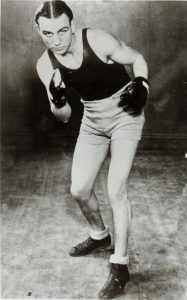
Jackie Fields had two reigns as welterweight champ at the start of the 1930s.
The 1924 US Olympic gold medalist at featherweight, Fields would rise to be the leading jr. welterweight contender in 1928 before settling in as a central figure at welterweight for most of the next five years. Fields defeated Young Jack Thompson for the vacant NBA title in 1929 before assuming the champion’s mantle for the first time in The Ring with a victory over Joe Dundee. Fields retired while ranked the leading contender to the crown after his second reign was ended by Young Corbett III.
Missing Quality: Fields only stoppage loss came in his seventh fight to future welterweight champion Jimmy McLarnin. Additional wins over King Tut, Baby Joe Gans, and Vince Dundee when those men were outside the rankings provide additional evidence of the tough schedule Fields kept at his best.
Scoring Results:
[Sammy Mandell ND 12 – (1) – 135
Louis Kaplan L10 – (6) – 135 – 02/27]
Mushy Callahan W 10 – (2) – 140 – 02/28
[Vince Dundee W 10 – (7+) – 147
Sammy Mandell L 10 – (C-) – 135 – 03/28]
Vince Dundee W 10 – (8+) – 147 – 05/28
[Young Jack Thompson W 10 – (1) – 147
Sgt. Sammy Baker KO 2 – (2) – 147 – 11/28]
Baby Joe Gans W 10 – (2-) – 140 – 03/29
Young Jack Thompson UD 10 – (2) – 147 – 04/29
Joe Dundee DQ 2* – (C) – 147 – 08/29
Gorilla Jones W 10 – (2) – 147 – 11/29
Gorilla Jones NC 7 – (3) – 147 – 01/30
Vince Dundee UD 10 – (5) – 147 – 01/30
Young Corbett III L 10 – (3) – 147 – 03/30
Tommy Freeman TKO 4 – (4) – 147 – 05/30
Young Jack Thompson L 15* – (2) – 147 – 06/30
[Paul Pirrone W 10 – (10) – 147
Bucky Lawless KO 5 – (8) – 147 – 01/31]
Jackie Brady UD 10 – (8) – 147 – 04/31
Young Terry L 10 – (6+) – 160 – 10/31
King Tut W 10 – (6) – 147 – 11/31
Jimmy Belmont D 10 – (UR) – 147 – 12/31
Lou Brouillard W 10* – (C) – 147 – 03/32
Johnny Indrisano L 10 – (UR) – 147 – 04/32
Eddie Murdock L 10 – (UR) – 147 – 02/33
Young Corbett III L 10* – (2) – 147 – 03/33
Young Peter Jackson W 10 – (4-) – 135 – 06/33
***
Click here to read 100-91.
Click here to read 90-81.
Click here to read 80-71.
Click here to read 70-61.
Scoring Details:
Scoring for total points and peak points relied on a base 11-point scale (i.e. a champion and the top 10 contenders).
A win over the champion of one’s weight class, in a title or non-title fight, was worth 11 points, a No. 1 contender was worth 10, etc.
Losses worked in reverse. A loss to the champion was a one-point deduction sliding to 11 for a loss to the No. 10 contender.
Losses to unranked opponents drew a universal 12-point deduction. Draws against ranked opponents were worth half a win; draws against unranked opponents were a six-point deduction.
Fighters were then given a ranking in each scoring category: overall total, peak score (the highest point their points for wins and losses reached), and ranked wins.
Wins and losses to opponents in higher and lower divisions were included. A formula based on body weight percentage differences between divisions of ranked fighters, rather than scale weights of the fighters, was applied.
For instance, if a No. 2-ranked bantamweight defeated the No. 2-ranked featherweight, 126 was divided by 118 and then multiplied by standard win/loss points, making the win worth 9.61 points to the bantamweight and the loss a deduction of 3.2 points for the featherweight. If the featherweight won, 118 would be divided by 126 with the win worth 8.42 points for the featherweight and the loss meaning a deduction of 2.81 points for the bantamweight.
The exception was fighters moving up to face heavyweights. There is no specific heavyweight ceiling so the formula divides the weight limit of the smaller fighter’s division against the actual weight of the heavyweight.
Everyone who finished in the top 100 of preliminary research for those three categories was moved into a final pool of what came out to 150 fighters. Win total ties were broken based on peak score. Their rankings in each category were then averaged into a final score.
To best display the range of data, they were then divided into four groups to settle on the final 100.
Group one: anyone who finished in the top 100 of all three scoring categories or whose scoring average was higher than those who did. (1-64).
Group two was anyone else who finished in the top 100 for peak score and ranked wins but not overall points (65-69).
Group three was derived from fighters who scored in the top 75 of any of the three scoring categories or whose final scoring average was higher than what would otherwise be the bottom ten of the top 100 (70-100).
The final average score was used to order the fighters in each group for those who made the top 100.
The study tried to respect the varying standards The Ring has used to rank fighters over the last century. For instance, champions haven’t automatically secured the top spot in every era of Ring rankings. Mike McTigue was the light heavyweight champion for the inaugural rankings in 1925 and was rated fourth.
For the 1925 rankings, and the period when Ring didn’t recognize single champions from 1989 to 2001, only 10 fighters per weight class were ranked. The points scale shifted for those years. The No. 1-ranked fighter became the 11-point win, deduction for an unranked loss was eleven points, and unranked draws were a 5.5-point deduction.
The 1926 and subsequent annual rankings prior to the introduction of monthly rankings included more than 10 fighters so the first 11 were all factored in.
The study is primarily based on monthly rankings. However, for a lengthy period of time the February, and later March, issue of the magazine would only feature the annual ratings for the year. Those were treated as that month’s rankings and, if needed, were reordered as champion and top 10 to maintain consistency.
Rankings from 1925-1928 had no monthly movement. The solution was to include all results from 1924 in evaluating 1925 and then applying six-month increments with spare exception near mid-year dates until the debut of monthly rankings; i.e. results from January-June 1925 used the 1925 annual and the rest of the year used 1926’s.
















